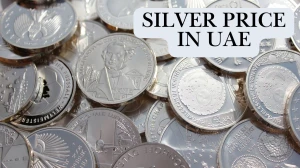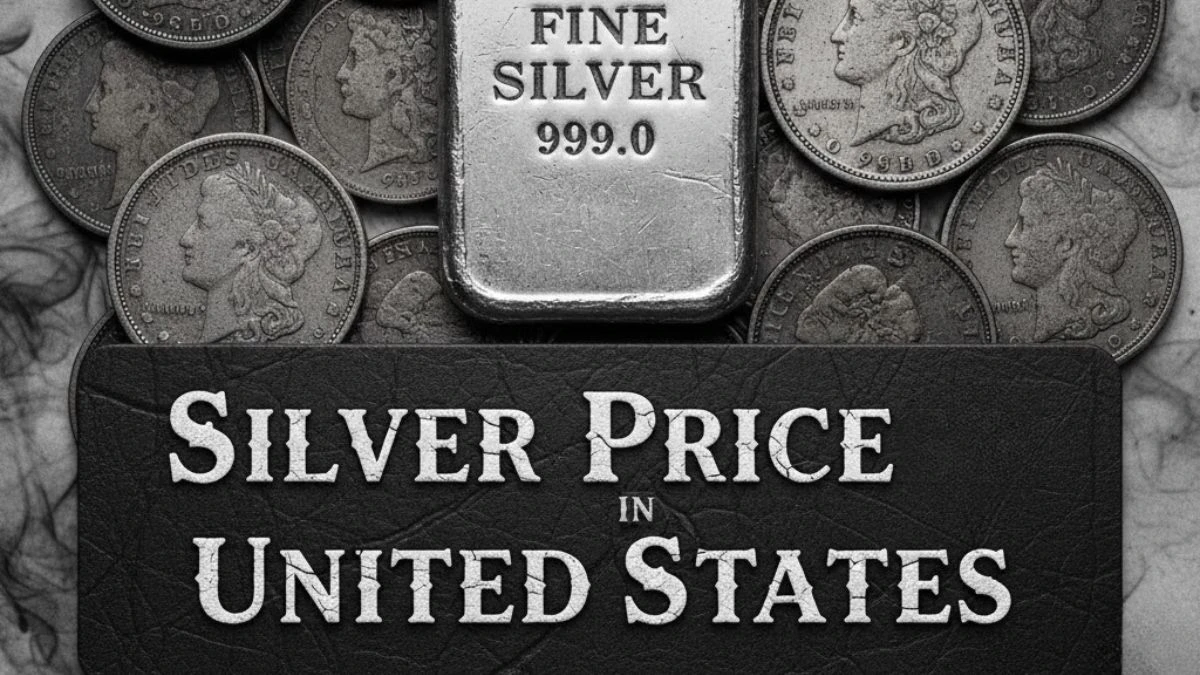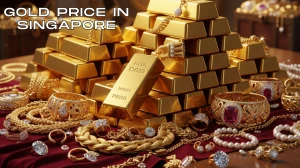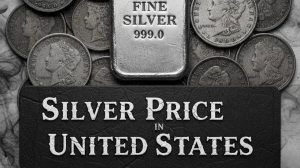
Silver Price Today in United States - Live Sterling & Fine Silver Rates (November 2025)
Live silver prices in United States today: Sterling silver (92.5%) at $1.56/gram and Fine silver (99.9%) at $1.68/gram. Updated hourly with market trends, investment tips, and city-wise rates.
by Admin
Published Nov 19, 2025 | Updated Nov 19, 2025 | 📖 8 min read
On This Page
- Live Silver Rates in United States Today
- Understanding Sterling, Fine, and Coin Silver Purity
- Silver Price Movement in USA - Last 7 Days
- Why Silver Prices Change Daily in the United States
- Silver Investment Options in the United States
- Total Cost of Buying Silver Jewelry in the United States
- State Sales Tax on Silver Purchases
- Is Today a Good Day to Buy Silver in the United States?
- Top US Silver Dealers (Lowest Premiums)
- Conclusion: Silver Investment Strategy for US Buyers
The current silver price in the United States stands at $1.56 per gram for Sterling silver (92.5%) and $1.68 per gram for Fine silver (99.9%) as of November 19, 2025. Silver prices in the United States are updated hourly based on international spot prices from the London Bullion Market Association (LBMA) and COMEX exchange rates. Whether you're buying sterling silver jewelry, investing in fine silver coins and bars, or considering silver ETFs, understanding today's silver rates across different American markets is essential for making informed financial decisions.
This comprehensive guide provides live silver prices for major US cities, explains why prices vary between locations, and offers insights into factors affecting silver rates today. We'll also help you understand the difference between Sterling (92.5%), Fine (99.9%), and Coin silver (90%) and provide practical tips on calculating the total cost of silver jewelry including making charges and state taxes.
Live Silver Rates in United States Today
Silver prices remain relatively consistent across major US cities, with minor variations due to local dealer premiums and state sales taxes. Here are today's silver rates in major American markets:
| Purity Type | Price per Gram | Price per Troy Ounce | 24-Hour Change |
|---|---|---|---|
| Sterling Silver (92.5%) | $1.56 | $48.52 | +0.08% |
| Fine Silver (99.9%) | $1.68 | $52.39 | +0.08% |
| Coin Silver (90%) | $1.52 | $47.28 | +0.08% |
Note: Silver prices are updated hourly based on COMEX spot rates and LBMA London exchange. For live prices with our FREE Silver Calculator, visit our Silver Price Tool.
Understanding Sterling, Fine, and Coin Silver Purity
Silver purity significantly affects both the price and usability of silver products. Understanding these categories is crucial when buying silver jewelry or investing in bullion.
Sterling Silver (92.5% Pure) - Most Popular for Jewelry
Current Price: $1.56 per gram
Purity: 92.5% silver + 7.5% other metals (usually copper)
Common Uses: Jewelry, silverware, decorative items, branded pieces (Tiffany & Co., Cartier)
Characteristics: Perfect balance of purity and durability. The 7.5% copper alloy prevents tarnishing and adds strength, making it ideal for everyday wear. Sterling silver is the global standard for silver jewelry.
Fine Silver (99.9% Pure) - Investment Grade
Current Price: $1.68 per gram
Purity: 99.9% pure silver
Common Uses: Investment coins (American Silver Eagles, Canadian Maple Leafs), bullion bars, IRA investments
Characteristics: Maximum purity and highest resale value. Too soft for regular jewelry but preferred by investors and collectors. Recognized worldwide as bullion standard.
Coin Silver (90% Pure) - Historical US Standard
Current Price: $1.52 per gram
Purity: 90% silver + 10% copper
Common Uses: Pre-1965 US coins (quarters, dimes, half dollars), antique silverware
Characteristics: Historical American silver standard. More durable than sterling but less pure. Commonly found in junk silver collections.
Price Comparison Per Troy Ounce (31.1g):
- Fine Silver (99.9%): $52.39 per oz
- Sterling Silver (92.5%): $48.52 per oz
- Coin Silver (90%): $47.28 per oz
Silver Price Movement in USA - Last 7 Days
Silver prices have shown moderate volatility over the past week, influenced by US dollar strength, Federal Reserve policy signals, and industrial demand indicators. Here's how Sterling and Fine silver prices have moved:
| Date | Fine Silver ($/g) | Sterling Silver ($/g) | Daily Change |
|---|---|---|---|
| Nov 19, 2025 | $1.68 | $1.56 | +0.08% |
| Nov 18, 2025 | $1.68 | $1.55 | -0.12% |
| Nov 17, 2025 | $1.68 | $1.56 | +0.15% |
| Nov 16, 2025 | $1.67 | $1.55 | -0.18% |
| Nov 15, 2025 | $1.70 | $1.57 | +0.22% |
| Nov 14, 2025 | $1.66 | $1.54 | -0.14% |
| Nov 13, 2025 | $1.68 | $1.56 | +0.10% |
Weekly Analysis: Silver prices have shown moderate stability with the weekly average for Fine silver at $1.68 per gram and Sterling at $1.56 per gram. The metal is trading slightly above its 7-day moving average, indicating mild bullish momentum.
Why Silver Prices Change Daily in the United States
Silver is one of the most volatile precious metals, with prices fluctuating multiple times daily due to its dual role as both an investment asset and industrial commodity.
Key Factors Affecting US Silver Prices
1. COMEX Silver Futures (Primary Driver)
The COMEX exchange in New York is the world's largest silver futures market. COMEX silver spot price serves as the global benchmark. Currently trading around $31-32 per troy ounce, COMEX prices directly determine US retail silver rates.
2. US Dollar Strength
Silver is priced globally in US dollars. When the dollar strengthens against other currencies, silver becomes more expensive for international buyers, typically reducing demand and lowering prices. Conversely, a weaker dollar boosts silver prices.
3. Federal Reserve Interest Rate Policy
The Federal Reserve's monetary policy significantly impacts silver. Lower interest rates make non-yielding assets like silver more attractive compared to bonds and savings accounts. Rate hikes have the opposite effect.
4. Industrial Demand (50% of Silver Consumption)
Unlike gold, over 50% of silver is consumed by industries:
- Electronics: Smartphones, computers, semiconductors (silver's conductivity)
- Solar Panels: Photovoltaic cells use significant silver (growing sector)
- Medical Applications: Antibacterial properties in equipment and bandages
- Automotive: Electric vehicle electronics and sensors
5. Gold-to-Silver Ratio
Historically, silver trades at a ratio of 50-80:1 against gold. Currently at approximately 80:1 (gold $2,650/oz ÷ silver $32/oz = 82.8). When this ratio exceeds historical norms, silver is considered undervalued relative to gold, attracting investors.
Silver Investment Options in the United States
American investors have numerous ways to gain silver exposure, each with distinct advantages and tax implications.
1. Physical Silver Bullion (Coins & Bars)
American Silver Eagles (99.9% Pure)
Price: $1.68/gram + $2-4 dealer premium per coin
Weight: 1 troy ounce (31.1g) = approximately $54-56 total
Pros: US government-backed, highly liquid, IRA-eligible, no sales tax in many states
Cons: Storage costs, insurance needs, dealer premiums
Best For: Long-term investors, wealth preservation, coin collectors
90% Silver US Coins (Junk Silver)
Price: $1.52/gram
Types: Pre-1965 quarters, dimes, half dollars
Pros: Recognizable, divisible, lower premiums than bullion coins
Cons: 90% purity (vs 99.9% bullion), wear and tear affects value
Best For: Small investors, barter scenarios, fractional silver holdings
Silver Bars (1oz to 100oz)
Price: $1.68/gram + $0.50-1.50/oz premium
Sizes: 1oz, 5oz, 10oz, 100oz
Pros: Lowest premium per ounce, efficient storage, pure investment play
Cons: Less divisible, requires authentication, storage security
Best For: Serious investors, large positions, lowest cost per ounce
2. Silver ETFs (Exchange-Traded Funds)
iShares Silver Trust (SLV)
Expense Ratio: 0.50% annually
Pros: Instant liquidity, no storage hassles, tradeable like stocks
Cons: Annual fees, no physical ownership, subject to market hours
Tax Treatment: Taxed as collectibles (28% maximum rate on gains)
Aberdeen Standard Physical Silver Shares ETF (SIVR)
Expense Ratio: 0.30% annually
Pros: Lower fees than SLV, 100% physically backed silver
Best For: Cost-conscious ETF investors
3. Silver Mining Stocks
Major Miners: Pan American Silver (PAAS), First Majestic Silver (AG), Hecla Mining (HL)
Pros: Leveraged exposure (miners typically move 2-3x silver prices), dividends, operational upside
Cons: Company-specific risks, operational challenges, not direct silver exposure
Best For: Aggressive investors seeking higher returns than physical silver
4. Silver IRA (Individual Retirement Account)
Eligible Products: American Silver Eagles, certain bars and coins meeting IRS purity requirements (99.9%)
Pros: Tax-deferred growth, diversifies retirement portfolio, IRS-approved physical ownership
Cons: Custodian fees ($75-300/year), storage fees, early withdrawal penalties
Best For: Retirement savers seeking precious metals diversification
Total Cost of Buying Silver Jewelry in the United States
When purchasing sterling silver jewelry, the final price includes several components beyond just the silver spot price:
| Cost Component | Calculation (50g sterling bracelet) | Amount |
|---|---|---|
| Base Silver Price (92.5%) | $1.56 × 50g | $78.00 |
| Making/Crafting Charges | $2/g × 50g | $100.00 |
| Designer Premium (20%) | 20% of $178 | $35.60 |
| State Sales Tax (avg 7%) | 7% of $213.60 | $14.95 |
| TOTAL PURCHASE COST | $228.55 | |
Note: Designer brands (Tiffany & Co., David Yurman) may charge 100-300% premiums. Five US states have NO sales tax on precious metals: Alaska, Delaware, Montana, New Hampshire, Oregon.
State Sales Tax on Silver Purchases
Sales tax treatment varies significantly by state and purchase amount:
| State | Sales Tax Rate | Silver Tax Exemption |
|---|---|---|
| Alaska, Delaware, Montana, New Hampshire, Oregon | 0% | Full exemption |
| Arizona | 5.6% | Exempt if bullion |
| Texas | 6.25% | Exempt if purchase >$1,000 |
| California | 7.25%+ | Exempt if purchase >$1,500 |
| New York | 4% | Exempt if investment bullion |
For state-specific tax rules, consult your local precious metals dealer or tax advisor.
Is Today a Good Day to Buy Silver in the United States?
Current Market Assessment (November 19, 2025):
Price Trend: Slightly increasing (+0.08%)
Weekly Position: Trading at weekly average
Gold-to-Silver Ratio: 82.8:1 (slightly above historical average of 75:1)
Industrial Demand: Strong (solar panel production up 18% YoY)
Recommendation: MODERATELY FAVORABLE - Silver is fairly valued with mild upward pressure from industrial demand.
Best Times to Buy Silver in the USA
- When Gold-to-Silver Ratio Exceeds 85:1 - Indicates silver is historically cheap relative to gold
- During Summer Months (June-August) - Jewelry demand typically softens, creating buying opportunities
- On Price Dips Below $30/oz - Strong support level at $28-30/oz historically
- When US Dollar Weakens - Precious metals rally when dollar declines
- Federal Reserve Rate Cut Cycles - Lower rates boost non-yielding assets like silver
Top US Silver Dealers (Lowest Premiums)
1. APMEX (American Precious Metals Exchange)
Location: Oklahoma City, OK
Premium: $2.50-3.50 per oz over spot
Minimum: No minimum order
Shipping: Free on $199+
2. JM Bullion
Location: Dallas, TX
Premium: $2.25-3.25 per oz
Minimum: No minimum
Shipping: Free on $199+
3. SD Bullion
Location: Indianapolis, IN
Premium: $2.00-3.00 per oz (lowest premiums)
Minimum: $50 order
Shipping: Free on $199+
4. US Mint (American Silver Eagles Only)
Premium: $2.00 per oz (if available)
Note: Often sold out; authorized dealers mark up to $4-5/oz
Conclusion: Silver Investment Strategy for US Buyers
Silver offers unique advantages as both an industrial metal and monetary asset. At current prices of $1.56/gram (Sterling) and $1.68/gram (Fine), silver provides:
- Portfolio Diversification: Low correlation with stocks and bonds
- Inflation Hedge: Historical store of value for 5,000+ years
- Industrial Growth Exposure: Renewable energy and electronics demand increasing
- Affordability: Lower entry point than gold (1/82nd the price)
- Tax Advantages: Many states exempt bullion purchases from sales tax
Recommended Allocation: Financial advisors typically suggest 5-10% of investment portfolio in precious metals, with 60-70% in gold and 30-40% in silver.
For real-time silver prices, investment calculators, and market analysis, visit MarketsHost Silver Price Tracker. Track your portfolio with live COMEX updates every hour.




